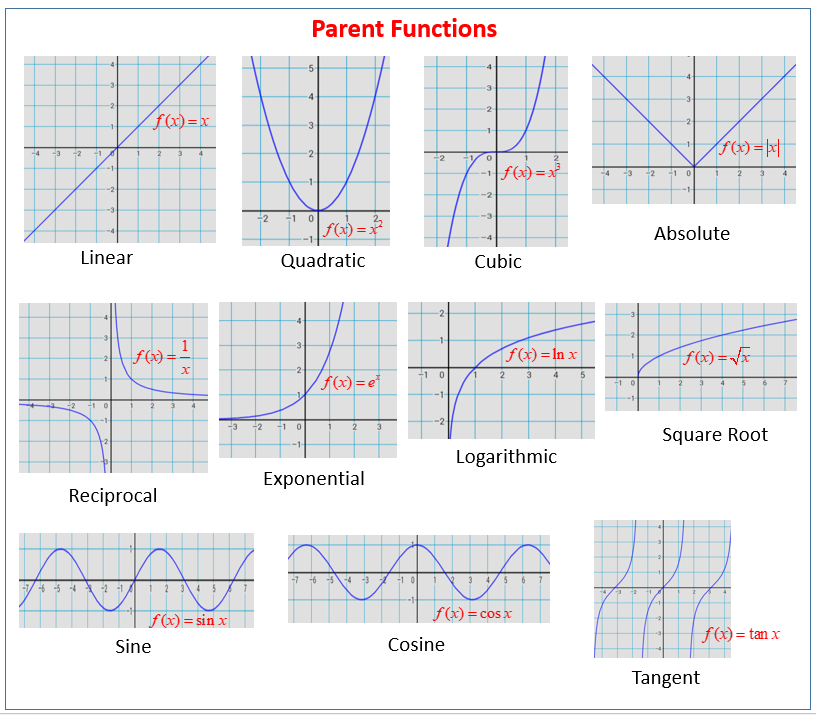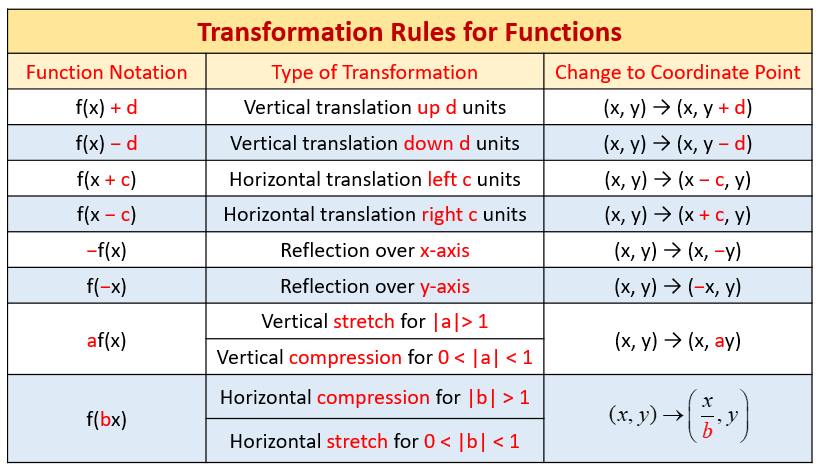Which Describes How to Graph by Transforming the Parent Function
Divide each y-value of the parent function by 3. Gx1 x4 3 d.

Parent Functions And Their Graphs Video Lessons Examples And Solutions
Use the maximum and minimum points on the graph of the cosine function as turning points for.

. On this lesson I will show you all of the parent function graphs parent function definition and their domain and rangeFor more MashUp Math content visit. Reflect the parent function over the x-axis and translate it 8 units to the left. Functions can get pretty complex and go through transformations like reflections along the x- or y-axis shifts stretching and shrinking making the usual graphing techniques difficult.
Move the graph of the parent function 3 units up. When you change the location or shape of a graph by changing the basic function often called a parent function we call that a transformation. Therefore to graph the given function reflect the parent function over the x-axis and translate it 8 units to the left.
Describe how to sketch the graph ofy -tan2x 3 using the parent function. Find f0 7 6 141 O 141 x. When we transform or translate a graph horizontally we either shift the graph to certain units to the right or to the left.
Which describes how to graph hx -3x 8 by transforming the parent function. Reflect over the vertical axis and then translate right 3 units. On which interval is the function decreasing.
Which equation is a quadratic function reflected over the x-axis and shifted up 2. Which describes how to graph h x RootIndex 3 StartRoot x EndRoot 3 using transformations of the parent function. When a constant is added to a parent term - for example when y x is changed to y x 2 - the new graph is translated 2 units up from the parent graph.
Compress the graph horizontally by making the period one-half pi. Describe the transformation to f x that results in g x. Lets try translating the parent function y x.
Tell how the graph transformed. Move the graph of the parent function 3 units down. Reflect over the horizontal axis and then translate the graph right 3 units.
The domain of the transformed function is the same as the parent function but the ranges of the functions. 0 If f x is the parent function afbx - c d is the transformed function where 6 0 5 6 a is the b is the c is the d is the stretch compression horizontal shift vertical shift To check your graph select some points. The parent function is.
Gx1 x-3 4 c. Stretch the graph of y cos x so the amplitude is 2. This will be a rigid transformation meaning the shape of the graph remains the same.
These transformations include horizontal shifts stretching or compressing vertically or horizontally reflecting over the x or y axes and vertical shifts. Since 8 is adding within the square root there is a horizontal translation of 8 units to the left. Which describes how to graph hx -RootIndex 3 StartRoot x EndRoot 3 using transformations of the parent function.
Reflect over the horizontal axis and then translate the graph up 3 units. The function f x c is given with gx kx. Describe how to sketch the graph ofy 2sec x - 3 using its reciprocal function.
Gx1 x3 4 b. The given function is. If the blue function is f xx 2 then the red function must be.
F x log x. What function is gx. Match the equation to its description.
Triple each y-value of the parent function. Determine the values of h and k in the equation of gx. You can see its graph in the figure.
And the parent graph of the family of quadratic functions is y x2 which is a parabola that opens upward and whose vertex is the origin. Name the parent function. Which statement describes how to transform the graph of fx x to get fx 3 x.
T -charts are extremely useful tools when dealing with transformations of functions. The graph of f x x is reflected across the x-axis and translated to the right 6 units. 3-7 7 6-6 y-intercept.
How to graph a transformed log All. Which statement about the domain and range of each function is correct. Parent Graphs and Transformations.
Draw vertical asymptotes where the graph crosses the x-axis. Graphing the logarithm f x log x. When a function is shifted stretched or compressed or flipped in any way from its parent function it is said to be transformed and is a transformation of a function.
Y 10 x Graphing the inverse function y 10 x. 21 Questions Show answers. Learn how to recognize shifts vertical and horizontal stretches and reflections as they affect parent functions in this free math video tutorial by Marios.
F x has been reflected over the y-axis. Match the equation to its description. Transformations and Parent Functions Complicated examples Sketch the following ftnctions.
Describe the transformations from the original parent function f. Since fa a what is. Since there is a negative multiply the transformed function there is a reflection in the x-axis.
Which is the graph of the function fx -x. Shift the graph of y 2cos x down 3 units. Reflect every point on the inverse function graph over the line y x.
The graph of f x x is transformed to g x x 1 - 7. Start by graphing the tangent function. If the blue function is f xx the red function must be.
Reflect over the horizontal axis and then translate the graph up 3 units. F x has been reflected over the x-axis. The next figure illustrates this last step which yields the parent logs graph.
The graph of reciprocal parent function fx1x is shifted 3 units up and 4 units to the right to create the graph of gx. Start by graphing the cosine function. Furthermore all of the functions within a family of functions can be derived from the parent function by taking the parent functions graph through various transformations.

Parent Functions And Their Graphs Video Lessons Examples And Solutions

No comments for "Which Describes How to Graph by Transforming the Parent Function"
Post a Comment